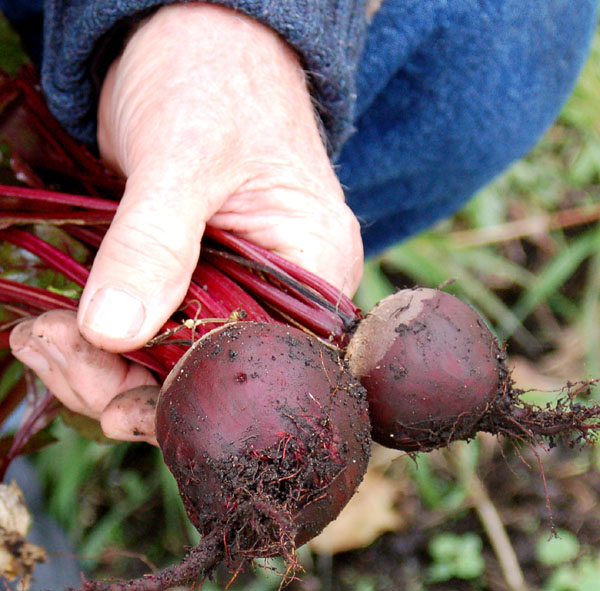
Kathryn Wadsworth
David has been talking about Storing Summer Bulbs. It got me thinking about all the things we who live in cold climates do to prepare for winter. As gardeners we store bulbs, corms, tubers, and tuberous roots. These plant structures store the net photosynthate that the plant produced during the growing season. Which means: plants store food to survive the winter and grow again in spring.
Somewhere in our pre-history we learned a lesson from plants and started storing these same plant parts for our own food. We “lift” tubers like potatoes (Solanum tuberosum) from the ground, shake dirt free and, in former times, placed them in root cellars. Today we might store them in cardboard boxes or burlap sacks in our garages. We also gather tuberous roots like sweet potatoes (Ipomoea batatas) and bulbs like onions and garlic, and store them through the long months of cold when we cannot grow food outside.
As November proceeds in the northern hemisphere, we prepare for festivals at which we gather and share our stored bounty from the garden. Storing food is all about coziness, feelings of safety, belonging, and abundance. Despite the hardships of the season – driving rain, cold, and snow – we enjoy our winter feasts.
David’s family cherishes traditional winter feasts. Mashed potatoes are a must. Close relatives of tomatoes, eggplants, chili, and bell peppers, potatoes come from high in the Andes of Peru, and have been grown for over 6,000 years. Breeders have mixed the gene pool to create the multitude of varieties we have now.
We all have favorite potatoes, but I particularly love the ones with tender skins and flavorful flesh, such as Yukon golds. I also like to mix it up with the newest – or oldest, depending on how you look at it – Peruvian blue and purple potatoes. But tradition often dictates the good old russet. No matter which potato we choose, I use a recipe I learned long ago:
Simple Mashed Potatoes
Potatoes: 2 lbs
Milk: enough to barely cover potatoes
Salt, pepper, butter to taste
Scrub the potatoes and leave skins on. Cut them in half-inch cubes. Boil them in milk until tender. Leave them in the pan with the milk, and start mashing, or pour the potatoes and milk into a bowl and mash. As you mash, add butter, salt and pepper to taste.
Sweet Potatoes come from lowlands throughout the Caribbean and South America, and people have been mixing genes from these gems of the earth for a long time to create many tasty cultivars. Some of these cultivars are also called yams by grocers in many areas of the U.S.
Still, our favorite bounty from the root cellar through the winter is:
Root Cellar Bounty
Bulbs: Onions, Garlic
Tubers: Potatoes
Roots: Sweet potatoes, Beets, Carrots, Parsnips
Olive oil: enough to drizzle the vegetables in a thin coating
Favorite herbs: such as thyme, rosemary, and sage.
Cut all the vegetables into bite-sized pieces. Lay them in a single layer in a 9 x 13 baking dish. Drizzle them with the olive oil until thinly coated. Roast them in a 350 degree (F) oven until fork tender.
Yum. Oh, you should probably let them cool for a bit before you bite them. 

I love the fall for the colours and the root veggies!! and those beets – YUMM!!
Thanks for the recipe doing mashed potatoes with milk — I’m going to try that tonight…
want a few soup recipes using root veggies?
Would love to see some root veggie soup recipes. Would you like to share them here? Nice to hear from you. Hope you enjoy the warm, yummy bounty from the earth, All the best, Kathryn